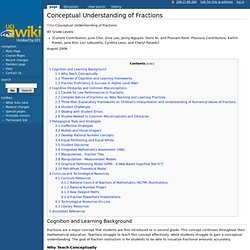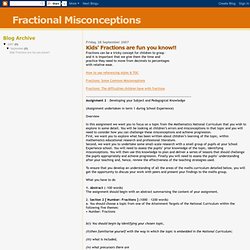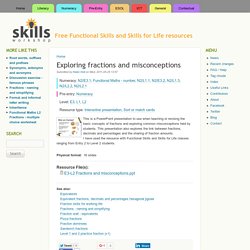

Conceptual Understanding of Fractions - UCI Wiki hosted by EEE - Nightly. Title Conceptual Understanding of Fractions All Grade Levels [Current Contributors: June Choi, Gina Lee, Jenny Nguyen, Doris Ni, and Poonam Patel; Previous Contributors: Kaitlin Franks, Jane Kim, Lori Labuzetta, Cynthia Leon, and Cheryl Panado] August 2008 Cognition and Learning Background Fractions are a major concept that students are first introduced to in second grade.

Why Teach Conceptually It is important for teachers to ensure that students have a firm grasp on the concepts of fractions. Brizuela (2005) explored the kinds of notations young children make for fractional numbers. Theories of Cognition and Learning Frameworks Zone Proximal Development Lev Vygotsky theorizes that every individual has a Zone of Proximal Development (ZPD) that varies for each concept. When students enter their classrooms, they bring with them knowledge of partitioning, fair share, and equality . Constructivism Fraction Proficiency & Success in Higher Level Math Cognitive Obstacles and Common Misconceptions 1. . Studentscommon misconceptions about fractions. Teachers Magazine - Nightly. MIN.pdf (application/pdf Object) HANDLING PUPILS' MISCONCEPTIONS - Nightly. Alwyn Olivier, Department of Didactics, University of Stellenbosch, Stellenbosch 7600 Presidential address delivered at the Thirteenth National Convention on Mathematics, Physical Science and Biology Education, Pretoria, 3 - 7 July 1989.

This paper will briefly delineate a theory for learning mathematics as a basis to reflect on (some particular) misconceptions of pupils in mathematics. Such a theory should enable us to predict what errors pupils will typically maketo explain how and why children make (these) errorsto help pupils to resolve such misconceptions. Teachers are often wary of theory - they want something practical. It is said that in Italy in the 1640's, the water table had receded so far that a very deep well had to be sunk in order to reach water. Finally, in 1643, Evangelista Torricelli, who invented the barometer, presented an alternative explanation (theory): It was not, he said, the pumps that pulled the water up. Let us again consider the role of theory. 2.1 Behaviourism. Count On - Nightly. Count On Resources Resources: Misconceptions in Mathematics This great new section elaborates some of the popular misconceptions in mathematics.

From multiplying with fractions to adding negative numbers, you'll find something of interest here. You will need to have Adobe Acrobat Reader installed in order to open these files. A lot more school mathematics is demystified in a new book DEMATHTIFYING: To see and purchase it visit www.mathsite.co.uk Rounding Numbers Multiplication can Increase or Decrease a Number Multiplying Decimals. Misconception in mathematics - Nightly. Fractional Misconceptions: Kids' Fractions are fun you know!! - Nightly.
Fractions can be a tricky concept for children to grasp –and it is important that we give them the time andpractice they need to move from decimals to percentageswith relative ease.

How to use referencing styles & TOC Fractions: Some Common Misconceptions Fractions: The difficulties children have with fractions -------------------------------------------------------------------------------------Assignment 2 – Developing your Subject and Pedagogical Knowledge (Assignment undertaken in term 1 during School Experience) Overview In this assignment we want you to focus on a topic from the Mathematics National Curriculum that you wish to explore in some detail. To ensure that you develop an understanding of all the areas of the maths curriculum detailed below, you will get the opportunity to discuss your work with peers and present your findings to the maths group. Misconceptions in mathematics and diagnostic teaching (Dennis Almeida) - Academia.edu - Nightly. EMI2a.pdf (application/pdf Object) Studentscommon misconceptions about fractions - Nightly. Conceptual Understanding of Fractions - UCI Wiki hosted by EEE. 71[1].Numerical value of fractions.pdf (application/pdf Object)
Fractions_booklet.pdf (application/pdf Object) - Nightly. Secondary Intervention : Common misconceptions - exploring fractions. If you have difficulty navigating this page, there is a text only version (will open a new window). This module focuses on the work of pupil A to model the process of identifying, predicting, uncovering and tackling misconceptions. Examine pupil A's responses to his work in class, which are shown below.
Question 4 above gets to the heart of pupil A's difficulties with decimals. What do his responses reveal? The response to question 11 above reveals another major conceptual error. What significant misconception concerning the ordering of fractions does the above demonstrate? In a few sentences, summarise pupil A's difficulties with fractions and decimals. Now read the researcher's comments on pupil A . Commentary on pupil A's work. Maths (Standards Unit) Main Menu > Thinking about learning > Using misconceptions > Overview - Nightly. Kids' Fractions are fun you know!! Valuing misconceptions on the way to explaining fractions. Maths_misconceptions. Why do fractions and decimals seem difficult to teach and learn?
C I M T - Misconceptions - Nightly. y8s9tn.pdf (application/pdf Object) Exploring fractions and misconceptions. Numeracy: N2/E3.1, Functional Maths - number, N2/L1.1, N2/E3.2, N2/L1.3, N2/L2.2, N2/L2.1 Pre-entry: Numeracy Level: E3, L1, L2 Resource type: Interactive presentation, Sort or match cards This is a PowerPoint presentation to use when teaching or revising the basic concepts of fractions and exploring common misconceptions held by students.

This presentation also explores the link between fractions, decimals and percentages and the sharing of fraction amounts. Physical format: 16 slides.